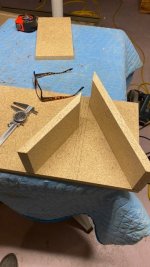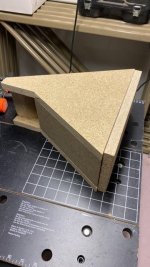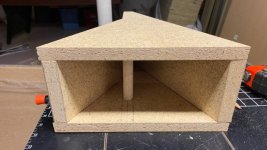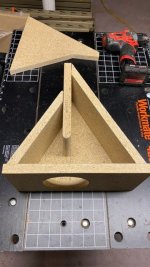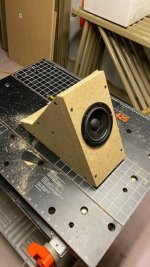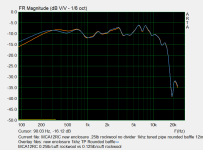Sure! My inspiration for this design was the idea that two waves out of phase would cancel. So, could I make a box that produced two reflected waves, one being 180 out of phase at the moment they arrive at the back of the speaker cone? One box can't do that but two boxes could if the 2nd box were 1.5x larger than the other. The distance from the cone to the wall define half the wavelength of the fundamental, but we don't want it to only work at one frequency but rather all frequencies, so I needed to have walls which had a continuously variable distance to the cone. Does it work?Do you mind to post pictures of your enclosure?
Attachments
Light polyfill? Can you try heavy fiberglass? For a mid enclosure you want to suppress everything inside it.
I did some experiments with various damping materials in a traditional box and found that when I filled the box densely the speaker became quieter and was not pleasant to listen to. Have others had a similar experience?
Then you seem to like internal enclosure resonances. 😊when I filled the box densely the speaker became quieter and was not pleasant to listen to.
Try not to get fooled by louder ("better") output.
Quieter is better. But it takes a long time listening to discover that.
Not possible to respond to if you do not provide more details.I did some experiments with various damping materials in a traditional box and found that when I filled the box densely the speaker became quieter and was not pleasant to listen to. Have others had a similar experience?
Well, there does need to be a 'method to the madness' 😉, so try critically damping it and having grown up with using FG insulation, stuffing in the form of differing thickness pieces/sheets just added, not stuffed per se, which reduces its insulation rating is best overall and not a bad plan to loosely cover the driver, any electronics with cheesecloth or similar. cloth.I did some experiments with various damping materials in a traditional box and found that when I filled the box densely the speaker became quieter and was not pleasant to listen to. Have others had a similar experience?
Attachments
Interesting concept, though looking at the box I see two Helmholtz resonators, the smaller volume side having a higher Fb (box tuning) than the larger.Sure! My inspiration for this design was the idea that two waves out of phase would cancel. So, could I make a box that produced two reflected waves, one being 180 out of phase at the moment they arrive at the back of the speaker cone? One box can't do that but two boxes could if the 2nd box were 1.5x larger than the other. The distance from the cone to the wall define half the wavelength of the fundamental, but we don't want it to only work at one frequency but rather all frequencies, so I needed to have walls which had a continuously variable distance to the cone. Does it work?
Rather than a broad-band phase inversion cancelling the speaker's back wave as you envisioned, the two tuned resonators would alternately feed a resonant phase inverted "tail" impulse between the two cabinet sides, the cone transmitting some of that to the outside world.
I would imagine that behavior would mess up frequency and decay response compared to a simple triangular box of the same enclosed volume.
Yes.I did some experiments with various damping materials in a traditional box and found that when I filled the box densely the speaker became quieter and was not pleasant to listen to. Have others had a similar experience?
"Just enough" damping material can increase the virtual cabinet volume by ~15% as the behavior of the air goes from adiabatic towards isothermal, lowering the resonant frequency, increasing low frequency output.
Conversely, "too much" damping material reduces the actual cabinet volume, raising the resonant frequency, creating an unpleasant mid-bass peak along with reduced low frequency output.
Art
@snives
yes, it takes some listening experience that quieter is better.
I remember my fight with a Manger driver in the 90ies which has a thin foil as a diaphragm and it was extremely acoustical transparent in its large enclosure.
Then I was a beginner in hifi and I always liked the lighter stuffing but after some time found out it just colours the sound.
But I respect fun loudspeaker concepts where everything resonates but sounds vivid.
Old tube radios were built like this.
yes, it takes some listening experience that quieter is better.
I remember my fight with a Manger driver in the 90ies which has a thin foil as a diaphragm and it was extremely acoustical transparent in its large enclosure.
Then I was a beginner in hifi and I always liked the lighter stuffing but after some time found out it just colours the sound.
But I respect fun loudspeaker concepts where everything resonates but sounds vivid.
Old tube radios were built like this.
I can see that too, but the way I look at it is that the speaker is the one exciting the box. Consider the speaker playing the resonant frequency of just one side of the box, lets say a 300hz sine wave, the other box would have a 300hz wave going through it as well, but because is 1.5 larger its not exciting its fundamental (200hz) at all but rather its reflecting the 300hz wave back exactly 1/2 wavelength out of phase. Looking at it differently, if one side were 2x as large as the other then both would be excited at 300hz, one the fundamental and the other its 2nd harmonic.looking at the box I see two Helmholtz resonators, the smaller volume side having a higher Fb (box tuning) than the larger.
I can take out the divider in between and see what that does (if anything).
My money is on a smoother frequency response with less resonant energy storage without the divider.I can take out the divider in between and see what that does (if anything).
Looking forward to the comparison!
It does occur to me that if one box were tuned to 300hz, and the other 200hz, that they would be in phase at 600hz (2nd harmonic and 3rd harmonic). So the theory of every frequency canceling, maybe doesn't hold up.
Anyways, I pulled the divider and remeasured the burst decay and frequency response.
I made 3 test measurements, divider vs no divider, and without the divider I measured poly vs rockwool.
Divider with polyfill:
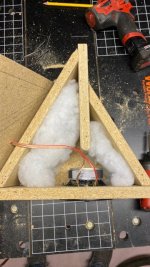
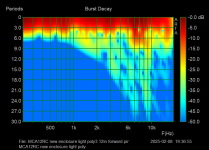
No divider, with polyfill:
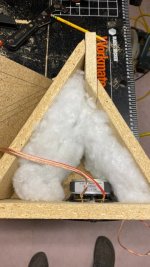
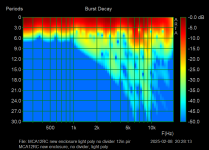
No divider, with rockwool:
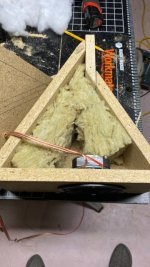
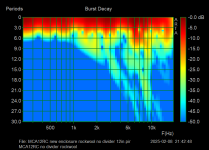
Interesting region around 4k and 2.4k
And some comparisons on the effects upon frequency response
Divider vs no divider:
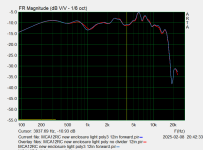
Polyfill vs Rockwool:

There should be some good data in there to pick apart and come to some conclusions..
Anyways, I pulled the divider and remeasured the burst decay and frequency response.
I made 3 test measurements, divider vs no divider, and without the divider I measured poly vs rockwool.
Divider with polyfill:


No divider, with polyfill:


No divider, with rockwool:


Interesting region around 4k and 2.4k
And some comparisons on the effects upon frequency response
Divider vs no divider:

Polyfill vs Rockwool:

There should be some good data in there to pick apart and come to some conclusions..
Stuff more Rockwool in there. Think of densities above 40kg/m3 (do the imperial conversion yourself 😛). Don't even look at the polyfill any more. You could protect the driver with some cloth or panty hose if you're worried (I would do so).
The burst decays look quite clean to me, cone resonances and secondary sources (baffle) seem dominant. Do you measure with the microphone really close (few mm) to the cone?
The burst decays look quite clean to me, cone resonances and secondary sources (baffle) seem dominant. Do you measure with the microphone really close (few mm) to the cone?
Its a new day, and I have done some more research, testing and experimentation.
Comparing a normal enclosure vs one with a pipe tuned for 1khz.
As an attempt to boost up a dip at 1khz I implemented a tuned pipe. The formula for a tuned pipe with one closed end and one free end is F=nc/4L where F is the frequency, n is the harmonic number, c is the speed of sound (1125ft/s, 343m/s), L is the length of the pipe (use appropriate units throughout). In my case I wanted a 1090hz tune which put the length at 3.10". Out of curiosity more than anything I was interested in understanding whether the interior of the enclosure actually made any difference whatsoever. Some say it doesn't even matter and that damping is really the only thing that matters. Others cling to ideas of golden ratios and non-parallel walls that probably apply more to woofers at lower frequencies than for midrange. So just how much of a difference would positioning a tuned pipe directly adjacent to a midrange driver in the enclosure make?
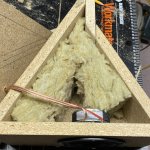
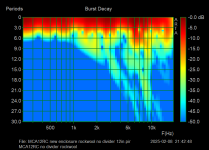

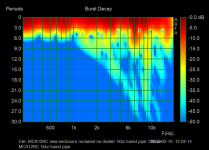
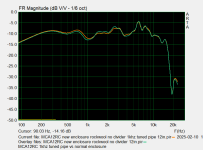
Results in the FR chart should that the center of the boost seems to be centered around 900hz, unsure why but that's the data, and that it does actually increase the spl by about 1 db. Pipes with one closed end and one free end have odd harmonics (1,3,5) so what we should expect is for the harmonics to show up at 2700hz, 4500hz. Here is the spl of the tuned pipe minus the normal enclosure to see the difference it made more clearly.
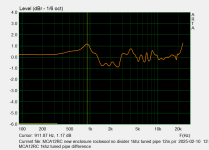
We can see it also is out of phase in the 1500-2500hz region and a harmonic at 4k. Perhaps we can use this to our advantage?
Comparing an enclosure with a flat baffle vs driver with back side 1/2" round over.
I have read that rounding over or chamfering the back bezel of the driver mounting hole is recommended (Troels Gravesen), but what does it do, is it audible? (Also amusingly we are both using the same driver to test with).
For this I am using the same arrangement from above with the tuned pipe in it, and just performing a before and after.

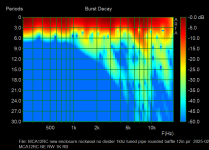
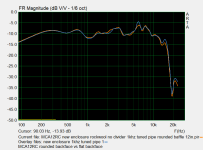
It appears the biggest change was reducing the peak at 6khz by 1.7db, likely caused by reflection. Unexpectedly it adds a 1db peak at 2200hz among various other peaks. Here's a chart of just the differences. If we switch from 1/6th octave smoothing to something like 1/2 octave smoothing the general trend is that it reduces some 3khz-9khz midrange and presence of the response but only by on average ~0.5db, which I am not even sure is audible by definition. Does it even matter?
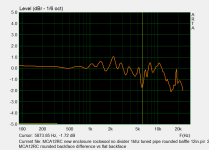
Comparing light damping vs heavy damping
Here I compare the same enclosure with 20kg/m3 (1/8 Lb/cu.ft.) rockwool damping vs 40kg/m3 (1/4 Lb/cu.ft.) rockwool damping.
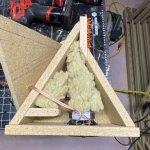

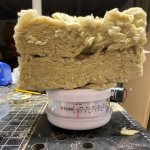
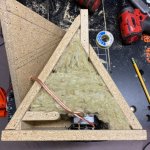
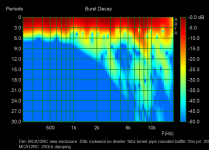
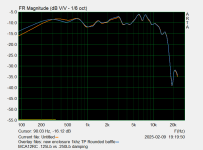
I see an increasingly widening null in the burst decay sonogram at 4khz, but its not as if we see that across the entire frequency spectrum. As a midrange driver I am predominantly concerned with the 500hz-5000hz range and it would seem that the rockwool damping material, whether packed loosely or densely is performing in the same region. That is, adding more, doesn't improve across the spectrum, it deepens the damping in the range which it is already effective in.
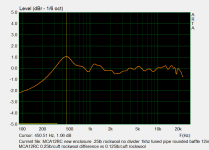
Looking at differences only something unexpected was the 1db bump at 400hz, and the 0.5db dip at 2.5khz, but it doesn't really affect the frequency response all that much. But of course the sound of it is what is important and so I set out to listen to the difference between the differently damped cabinets. And I cannot say it was apparently on all songs, but some songs the heavily damped cabinet sounded congested. Although not important with a midrange I did notice some reduced bass. Subjectively though I am more concerned about preserving or extracting the most natural sound from the audio source. I've listened for the better part of a day, A/B-ing the two and at this moment I can honestly say I am not convinced either way. There are some aspects of the more open and natural sound of a lightly damped cabinet and a more accurate but dead sounding densely stuffed enclosure. Obviously these are opinions and even I have not made up my mind on which I prefer. But we are talking about 1db here and there and honestly its very very difficult to pick that out in music. When critically listening, I prefer to listen to songs with human voice because with that I have half a chance of detecting difference whereas with dynamic electronic music, rock guitars, everything is just a minor effect.
Future direction
I am not certain where to go from here, but I think a good guess would be to experiment with different damping materials to target different frequency ranges. (Has this been done before? Is there a chart?) I also see some potential with the internal tuning pipe, though it will take some trial and error. I particularly like that it boosts and damps at different frequencies if that is what you need. When taken to an extreme, could we produce an interior volume comprised of fractal labyrinthine chambers which perfectly damp all regions? I will keep listening.
Comparing a normal enclosure vs one with a pipe tuned for 1khz.
As an attempt to boost up a dip at 1khz I implemented a tuned pipe. The formula for a tuned pipe with one closed end and one free end is F=nc/4L where F is the frequency, n is the harmonic number, c is the speed of sound (1125ft/s, 343m/s), L is the length of the pipe (use appropriate units throughout). In my case I wanted a 1090hz tune which put the length at 3.10". Out of curiosity more than anything I was interested in understanding whether the interior of the enclosure actually made any difference whatsoever. Some say it doesn't even matter and that damping is really the only thing that matters. Others cling to ideas of golden ratios and non-parallel walls that probably apply more to woofers at lower frequencies than for midrange. So just how much of a difference would positioning a tuned pipe directly adjacent to a midrange driver in the enclosure make?





Results in the FR chart should that the center of the boost seems to be centered around 900hz, unsure why but that's the data, and that it does actually increase the spl by about 1 db. Pipes with one closed end and one free end have odd harmonics (1,3,5) so what we should expect is for the harmonics to show up at 2700hz, 4500hz. Here is the spl of the tuned pipe minus the normal enclosure to see the difference it made more clearly.

We can see it also is out of phase in the 1500-2500hz region and a harmonic at 4k. Perhaps we can use this to our advantage?
Comparing an enclosure with a flat baffle vs driver with back side 1/2" round over.
I have read that rounding over or chamfering the back bezel of the driver mounting hole is recommended (Troels Gravesen), but what does it do, is it audible? (Also amusingly we are both using the same driver to test with).
For this I am using the same arrangement from above with the tuned pipe in it, and just performing a before and after.



It appears the biggest change was reducing the peak at 6khz by 1.7db, likely caused by reflection. Unexpectedly it adds a 1db peak at 2200hz among various other peaks. Here's a chart of just the differences. If we switch from 1/6th octave smoothing to something like 1/2 octave smoothing the general trend is that it reduces some 3khz-9khz midrange and presence of the response but only by on average ~0.5db, which I am not even sure is audible by definition. Does it even matter?

Comparing light damping vs heavy damping
Here I compare the same enclosure with 20kg/m3 (1/8 Lb/cu.ft.) rockwool damping vs 40kg/m3 (1/4 Lb/cu.ft.) rockwool damping.






I see an increasingly widening null in the burst decay sonogram at 4khz, but its not as if we see that across the entire frequency spectrum. As a midrange driver I am predominantly concerned with the 500hz-5000hz range and it would seem that the rockwool damping material, whether packed loosely or densely is performing in the same region. That is, adding more, doesn't improve across the spectrum, it deepens the damping in the range which it is already effective in.

Looking at differences only something unexpected was the 1db bump at 400hz, and the 0.5db dip at 2.5khz, but it doesn't really affect the frequency response all that much. But of course the sound of it is what is important and so I set out to listen to the difference between the differently damped cabinets. And I cannot say it was apparently on all songs, but some songs the heavily damped cabinet sounded congested. Although not important with a midrange I did notice some reduced bass. Subjectively though I am more concerned about preserving or extracting the most natural sound from the audio source. I've listened for the better part of a day, A/B-ing the two and at this moment I can honestly say I am not convinced either way. There are some aspects of the more open and natural sound of a lightly damped cabinet and a more accurate but dead sounding densely stuffed enclosure. Obviously these are opinions and even I have not made up my mind on which I prefer. But we are talking about 1db here and there and honestly its very very difficult to pick that out in music. When critically listening, I prefer to listen to songs with human voice because with that I have half a chance of detecting difference whereas with dynamic electronic music, rock guitars, everything is just a minor effect.
Future direction
I am not certain where to go from here, but I think a good guess would be to experiment with different damping materials to target different frequency ranges. (Has this been done before? Is there a chart?) I also see some potential with the internal tuning pipe, though it will take some trial and error. I particularly like that it boosts and damps at different frequencies if that is what you need. When taken to an extreme, could we produce an interior volume comprised of fractal labyrinthine chambers which perfectly damp all regions? I will keep listening.
Attachments
Would you post a picture of your measurement setup please? I think a lot of the burst decay readings is coming from the driver itself. The cone is obviously breaking up (like it should) but below that, behavior seems pretty ok to me.
Nothing fancy, it's a UMIK-1 on a tripod, positioned on axis 12" from the driver. Speaker cabinet is 39" off the ground. Measuring near field as you suggest is for measuring below the cutoff frequency of the gate (<333hz for the 3ms gate I'm using) and unsuitable for measuring midrange frequencies, and also below my intended crossover frequency.
I expect the 6k peak and beyond is from cone breakup, but also I will be low passing it at 3000hz with a 2nd order, so should be at least -12db at that point.
I expect the 6k peak and beyond is from cone breakup, but also I will be low passing it at 3000hz with a 2nd order, so should be at least -12db at that point.
@snives
looking at the mid driver enclosure I see left of the driver free undamped space.
Using damping its not necessary to stuff the box but to take care that the damping covers all reflective surfaces.
So you can use the initial amount of damping but fluff it up or spread it covering the space.
Is the tube like a reflex tube?
Then you leave the ground of hifi generating resonances.
Maybe the frequency response can be linearized with some more sophisticated crossover network.
Don Highend did "fill up" a frequency region by manipulating the impedance.
Watch page 7 of 39 measurement in his project "modern cool"
https://www.donhighend.de/?page_id=10592
looking at the mid driver enclosure I see left of the driver free undamped space.
Using damping its not necessary to stuff the box but to take care that the damping covers all reflective surfaces.
So you can use the initial amount of damping but fluff it up or spread it covering the space.
Is the tube like a reflex tube?
Then you leave the ground of hifi generating resonances.
Maybe the frequency response can be linearized with some more sophisticated crossover network.
Don Highend did "fill up" a frequency region by manipulating the impedance.
Watch page 7 of 39 measurement in his project "modern cool"
https://www.donhighend.de/?page_id=10592
Attachments
he describes the use of a shelving filter. If you have a resistance adapting the efficiency to bass and tweeter then a capacitor parallel to the resistance can give you a desired linearizing.

- Home
- Loudspeakers
- Multi-Way
- Help with sealed enclosure, midrange response, standing waves
